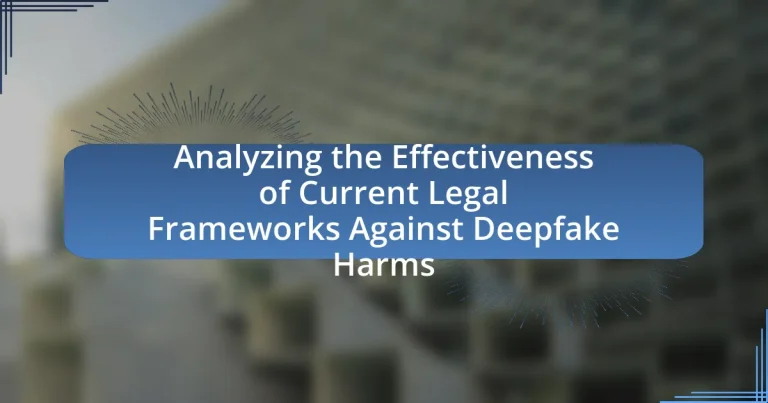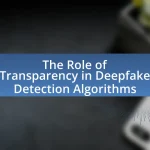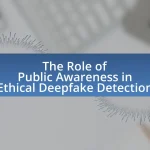The article focuses on the effectiveness of current legal frameworks in addressing the harms associated with deepfakes, which include misinformation, reputational damage, and threats to personal safety. It examines the psychological effects on victims, the impact on public perception and trust, and the legal definitions of deepfake-related offenses. The discussion highlights the challenges existing laws face, such as rapid technological advancements and jurisdictional issues, while also exploring recommendations for improving legal responses, including specific legislation and enhanced collaboration between tech companies and lawmakers. Additionally, the article outlines practical steps individuals can take to protect themselves from deepfake harms.
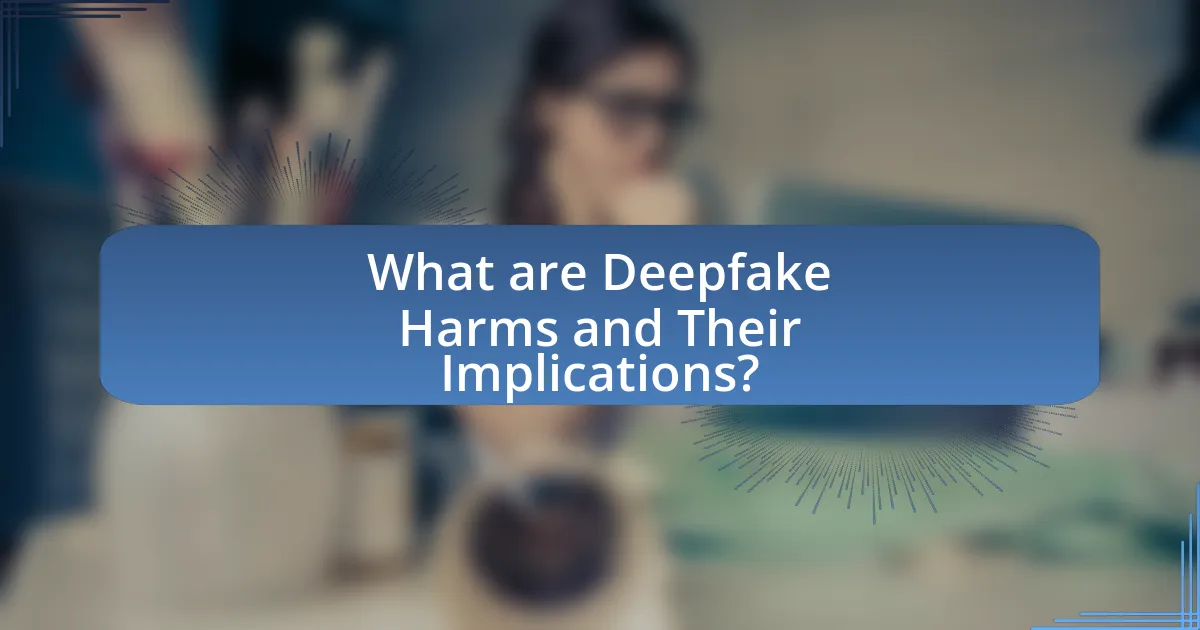
What are Deepfake Harms and Their Implications?
Deepfake harms include misinformation, reputational damage, and potential threats to personal safety. Misinformation arises when deepfakes are used to create false narratives, misleading the public and influencing opinions, as seen in political contexts where manipulated videos can sway voter behavior. Reputational damage occurs when individuals are depicted in compromising or false scenarios, leading to social ostracism or career repercussions; for instance, deepfake pornography has been reported to target public figures and private individuals alike, causing significant emotional distress. Additionally, deepfakes pose safety threats, as they can be employed in scams or to incite violence, exemplified by instances where fabricated videos have been used to incite riots or justify harmful actions. The implications of these harms extend to legal and ethical challenges, necessitating a reevaluation of existing legal frameworks to effectively address the risks associated with deepfakes.
How do deepfakes impact individuals and society?
Deepfakes significantly impact individuals and society by facilitating misinformation, damaging reputations, and undermining trust in media. Individuals can become victims of deepfake technology, leading to personal and professional harm, as evidenced by cases where manipulated videos have resulted in job loss or public humiliation. Society faces broader implications, including the erosion of trust in authentic media sources; a 2020 study by the Pew Research Center found that 51% of Americans believe deepfakes will cause significant harm to society. This technology poses challenges for legal frameworks, as existing laws often struggle to address the rapid evolution and anonymity associated with deepfake creation and distribution.
What psychological effects do deepfakes have on victims?
Deepfakes can cause significant psychological effects on victims, including anxiety, depression, and a loss of trust in personal relationships. Victims often experience feelings of humiliation and violation, as their likeness is manipulated without consent, leading to a distorted self-image. Research indicates that exposure to deepfake content can result in long-term emotional distress, as victims grapple with the implications of their image being used in harmful or misleading contexts. A study published in the journal “Cyberpsychology, Behavior, and Social Networking” highlights that individuals targeted by deepfakes report increased levels of paranoia and social withdrawal, further illustrating the profound impact on mental health.
How do deepfakes influence public perception and trust?
Deepfakes significantly undermine public perception and trust by creating realistic but fabricated content that can mislead audiences. Research indicates that exposure to deepfakes can lead to increased skepticism towards authentic media, as individuals struggle to discern truth from deception. A study published in the journal “Nature Communications” found that 96% of participants could not accurately identify manipulated videos, highlighting the potential for deepfakes to erode trust in visual media. Furthermore, deepfakes can amplify misinformation, as they are often used in political contexts to distort facts, thereby influencing public opinion and behavior. This manipulation of trust is particularly concerning in democratic societies, where informed decision-making relies on the integrity of information.
What types of deepfake harms are most prevalent?
The most prevalent types of deepfake harms include misinformation, identity theft, and reputational damage. Misinformation arises when deepfakes are used to create false narratives, misleading the public and influencing opinions, as seen in political contexts where fabricated videos can sway voter behavior. Identity theft occurs when individuals’ likenesses are manipulated to create fake content, leading to personal and financial repercussions. Reputational damage is evident when deepfakes are employed to create defamatory content, harming individuals’ careers and personal lives. Research indicates that these harms are increasingly common, with a report from the DeepTrust Alliance highlighting a significant rise in deepfake incidents across various sectors, underscoring the urgent need for effective legal frameworks to address these issues.
What are the legal definitions of deepfake-related offenses?
Deepfake-related offenses are legally defined as the creation, distribution, or use of synthetic media that misrepresents an individual’s likeness or voice, often with the intent to deceive or harm. These offenses can encompass various legal frameworks, including fraud, defamation, and privacy violations. For instance, in the United States, some states have enacted laws specifically targeting deepfakes, such as California’s AB 730, which criminalizes the use of deepfakes for malicious purposes, including election interference and non-consensual pornography. Additionally, federal laws like the Computer Fraud and Abuse Act may apply if deepfakes are used to commit fraud or impersonation. The legal definitions are evolving as technology advances, reflecting the need for updated regulations to address the unique challenges posed by deepfakes.
How do deepfakes contribute to misinformation and fraud?
Deepfakes contribute to misinformation and fraud by creating realistic but fabricated audio and video content that can mislead viewers. This technology enables the manipulation of public figures’ appearances and voices, making it possible to produce false statements or actions that can be disseminated widely, thereby distorting reality. For instance, a study by the University of California, Berkeley, found that deepfake videos can significantly influence public opinion, as viewers often struggle to discern the authenticity of the content. Additionally, deepfakes have been used in scams, such as impersonating executives in video calls to authorize fraudulent transactions, leading to substantial financial losses for businesses.
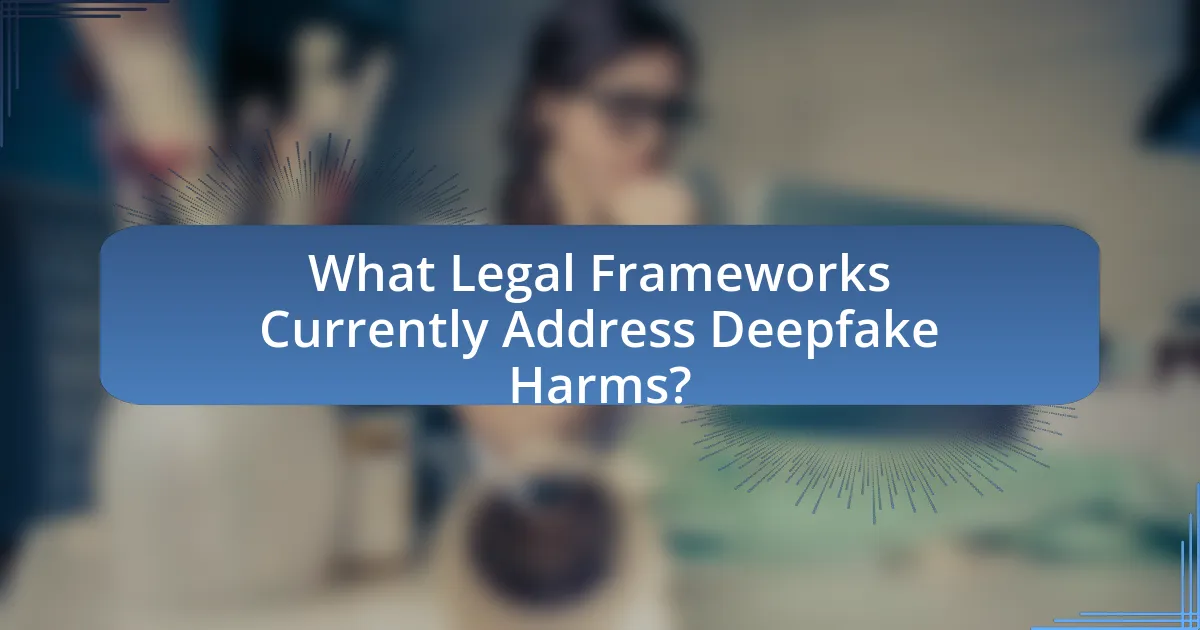
What Legal Frameworks Currently Address Deepfake Harms?
Currently, various legal frameworks address deepfake harms, including state laws, federal regulations, and international treaties. In the United States, several states have enacted specific laws targeting deepfakes, such as California’s AB 730, which criminalizes the use of deepfakes for malicious purposes, including defamation and fraud. Additionally, the federal government has proposed legislation like the Malicious Deep Fake Prohibition Act, which aims to penalize the creation and distribution of deepfakes intended to harm individuals or influence elections. Internationally, the European Union’s Digital Services Act includes provisions that could regulate harmful content, including deepfakes, by imposing obligations on platforms to remove such content. These frameworks collectively aim to mitigate the risks associated with deepfakes by establishing legal consequences for their misuse.
How effective are existing laws in combating deepfake issues?
Existing laws are currently limited in their effectiveness in combating deepfake issues. While some jurisdictions have enacted specific legislation targeting deepfakes, such as California’s AB 730, which criminalizes the malicious use of deepfake technology, enforcement remains challenging due to the rapid evolution of technology and the difficulty in proving intent. Additionally, existing laws often rely on broader legal frameworks, such as defamation or copyright laws, which may not adequately address the unique harms posed by deepfakes. For instance, a 2021 report by the Brookings Institution highlights that many legal systems lack the necessary tools to effectively regulate the creation and distribution of deepfakes, leading to gaps in protection for individuals affected by this technology.
What specific laws are in place to regulate deepfakes?
Several specific laws regulate deepfakes, including the Malicious Deep Fake Prohibition Act of 2018, which criminalizes the use of deepfakes to harm others, and various state laws that address the unauthorized use of someone’s likeness or voice. For instance, California’s AB 730 makes it illegal to use deepfakes to harm, defraud, or intimidate individuals. Additionally, the federal Defending Against Digital Disinformation Act aims to combat misinformation, including deepfakes, by enhancing transparency in digital media. These laws collectively aim to mitigate the potential harms associated with deepfakes, such as defamation and identity theft.
How do these laws vary across different jurisdictions?
Laws regarding deepfake technology vary significantly across different jurisdictions, reflecting diverse legal frameworks and cultural attitudes towards privacy, free speech, and technology regulation. For instance, in the United States, there is no federal law specifically addressing deepfakes, but various states have enacted legislation targeting malicious uses of deepfake technology, such as California’s law prohibiting the use of deepfakes for harassment or fraud. In contrast, the European Union is moving towards comprehensive regulations that could encompass deepfakes under its proposed Digital Services Act, emphasizing accountability for online platforms. Additionally, countries like Australia have introduced specific laws that criminalize the use of deepfakes in non-consensual pornography, showcasing a more proactive approach to protecting individuals’ rights. These variations illustrate how legal responses to deepfake harms are shaped by local contexts, priorities, and existing legal structures.
What challenges do current legal frameworks face?
Current legal frameworks face significant challenges in addressing the harms caused by deepfakes. These challenges include the rapid technological advancement of deepfake creation tools, which outpace existing laws, making it difficult to regulate effectively. Additionally, the ambiguity surrounding definitions of consent and ownership in digital content complicates legal enforcement. For instance, many jurisdictions lack specific laws targeting deepfake technology, leading to inconsistent legal responses. Furthermore, the cross-border nature of the internet creates jurisdictional issues, complicating the prosecution of deepfake-related offenses. These factors collectively hinder the ability of legal systems to protect individuals from the potential harms associated with deepfakes.
How do technological advancements outpace legal responses?
Technological advancements outpace legal responses primarily due to the rapid evolution of technology, which often introduces new capabilities and challenges faster than laws can be formulated or updated. For instance, the emergence of deepfake technology has created significant ethical and legal dilemmas, yet existing legal frameworks, such as defamation laws or privacy rights, struggle to address the unique characteristics of deepfakes, which can manipulate reality in ways that traditional media cannot. This gap is evident in the fact that many jurisdictions have yet to enact specific legislation targeting deepfakes, despite their increasing prevalence and potential for harm, as highlighted by a 2020 report from the Brookings Institution, which noted that only a handful of states in the U.S. had implemented laws specifically addressing deepfake technology.
What gaps exist in the current legal protections against deepfakes?
Current legal protections against deepfakes are insufficient due to several gaps, including the lack of specific laws targeting deepfake technology, inadequate definitions of harmful deepfake content, and challenges in enforcement across jurisdictions. Existing laws often rely on outdated frameworks that do not account for the rapid evolution of deepfake technology, leading to ambiguity in legal interpretations. For instance, while some states in the U.S. have enacted laws addressing non-consensual deepfake pornography, these laws do not comprehensively cover other malicious uses, such as misinformation or fraud. Additionally, the international nature of the internet complicates enforcement, as deepfake creators can operate from jurisdictions with weaker regulations. These gaps highlight the need for a more robust and unified legal approach to effectively combat the harms associated with deepfakes.
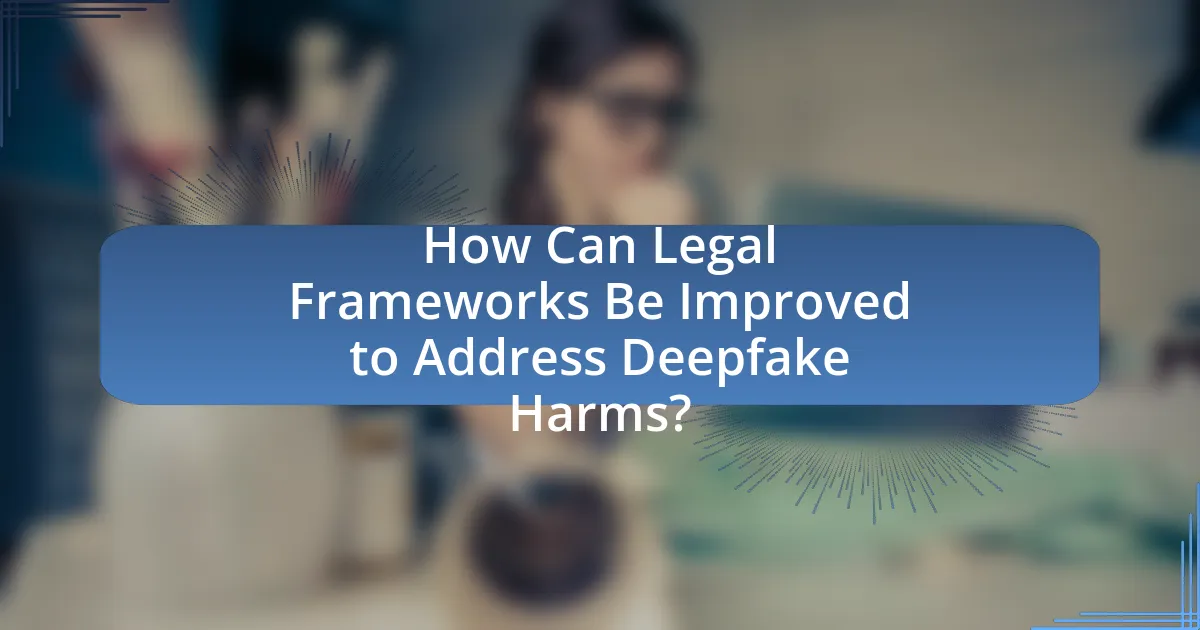
How Can Legal Frameworks Be Improved to Address Deepfake Harms?
Legal frameworks can be improved to address deepfake harms by implementing specific legislation that criminalizes the malicious use of deepfakes, enhancing penalties for offenders, and establishing clear definitions of deepfake technology. Current laws often lack specificity regarding digital manipulation, leading to challenges in prosecution. For instance, California’s AB 730, enacted in 2019, serves as a model by making it illegal to use deepfakes for harassment or to harm others, demonstrating the effectiveness of targeted legal measures. Additionally, integrating provisions for victim support and education on deepfake technology can empower individuals to recognize and report abuses, further strengthening the legal response to this emerging threat.
What recommendations exist for enhancing legal responses?
Recommendations for enhancing legal responses to deepfake harms include the establishment of specific legislation targeting the creation and distribution of deepfakes, as well as the implementation of clearer definitions of consent and harm in digital media. Research indicates that jurisdictions with tailored laws, such as California’s AB 730, which criminalizes the malicious use of deepfakes, have seen a reduction in incidents. Additionally, enhancing collaboration between technology companies and law enforcement can improve the identification and removal of harmful deepfake content, as evidenced by initiatives like the Deepfake Detection Challenge, which aims to develop better detection technologies.
How can laws be adapted to better address emerging deepfake technologies?
Laws can be adapted to better address emerging deepfake technologies by incorporating specific regulations that define and penalize the malicious use of deepfakes. Current legal frameworks often lack clarity on the distinction between legitimate and harmful deepfake content, which can lead to challenges in enforcement. For instance, jurisdictions can establish clear definitions of deepfakes and categorize them based on intent and potential harm, similar to how laws differentiate between types of fraud. Additionally, implementing stricter penalties for the creation and distribution of deepfakes intended to deceive or harm individuals can deter misuse. Evidence from recent studies indicates that jurisdictions with specific anti-deepfake laws, such as California’s AB 730, have seen a reduction in reported cases of deepfake-related harassment and fraud, demonstrating the effectiveness of targeted legal measures.
What role do international agreements play in regulating deepfakes?
International agreements play a crucial role in regulating deepfakes by establishing common legal standards and frameworks among nations. These agreements facilitate cooperation in addressing the challenges posed by deepfake technology, which can be used for misinformation, fraud, and privacy violations. For instance, the Council of Europe’s Convention on Cybercrime provides a basis for member states to collaborate on combating cybercrime, including the misuse of deepfake technology. Additionally, international agreements can promote the development of guidelines and best practices for the ethical use of artificial intelligence, thereby helping to mitigate the risks associated with deepfakes.
What best practices can be implemented for legal frameworks?
Best practices for legal frameworks addressing deepfake harms include establishing clear definitions of deepfakes, implementing specific regulations that target the creation and distribution of harmful deepfakes, and enhancing collaboration between technology companies and legal authorities. Clear definitions help in identifying what constitutes a deepfake, which is essential for enforcement. Regulations can include penalties for malicious use and requirements for labeling deepfake content. Collaboration can facilitate the development of technological solutions to detect deepfakes, as seen in initiatives like the Deepfake Detection Challenge, which aims to improve detection technologies through collective efforts.
How can collaboration between tech companies and lawmakers improve outcomes?
Collaboration between tech companies and lawmakers can improve outcomes by fostering the development of effective regulations that address the challenges posed by deepfakes. This partnership allows lawmakers to gain insights into technological advancements and the implications of deepfake technology, while tech companies can provide expertise on the practicalities of implementing regulations. For instance, the collaboration can lead to the creation of standards for identifying and mitigating deepfake content, which can enhance public trust and safety. Evidence of successful collaborations can be seen in initiatives like the Partnership on AI, where industry leaders and policymakers work together to establish ethical guidelines and best practices for AI technologies, including deepfakes.
What educational initiatives can support legal understanding of deepfakes?
Educational initiatives that can support legal understanding of deepfakes include specialized training programs for legal professionals, public awareness campaigns, and the integration of deepfake technology education into law school curricula. Training programs can provide lawyers and judges with the necessary knowledge to navigate the complexities of deepfake-related cases, while public awareness campaigns can inform the general public about the legal implications of deepfakes. Furthermore, incorporating deepfake technology into law school curricula ensures that future legal professionals are equipped with the understanding needed to address emerging challenges in this area. These initiatives are essential as they help bridge the knowledge gap and prepare stakeholders to effectively engage with the legal issues surrounding deepfakes.
What practical steps can individuals take to protect themselves from deepfake harms?
Individuals can protect themselves from deepfake harms by verifying the authenticity of media before sharing or believing it. This can be achieved through fact-checking tools and platforms that specialize in identifying manipulated content, such as Deepware Scanner and Sensity AI, which analyze videos for signs of deepfake technology. Additionally, individuals should be cautious about sharing personal information online, as this data can be used to create convincing deepfakes. Awareness of the technology behind deepfakes and staying informed about the latest developments in detection methods can further enhance personal security against such threats.
